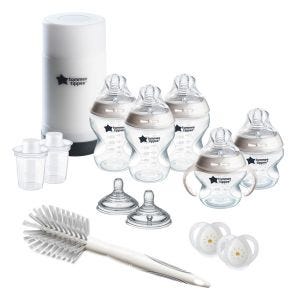
This is a demo store. No orders will be fulfilled.
Subscription orders can be cancelled at anytime. Free delivery on all subsequent subscription orders. Find out more about subscriptions.
They’re easy and fuss free
Your products are automatically sent to you
You save up to 10% when you sign up for a subscription
You can cancel at any time
Lots of people experience some level of nipple tenderness when they first start breastfeeding, usually when their baby first latches. But this initial discomfort should ease up the more you breastfeed and get into a feeding position that's comfortable for you and your baby.
For some, sore nipples can be an ongoing issue. As many as 90% of new moms experience them at some point. Thankfully, though, there're plenty of ways to alleviate nipple pain, tenderness, or soreness.
Let's run through why you may be experiencing nipple pain when breastfeeding, cover some top tips for sore nipple relief, and answer some of the most common questions moms ask about nipple soreness.
One of the most common causes of sore nipples when breastfeeding is that the baby's latch or positioning isn't correct. This can be because:
If you can, it's important to carry on breastfeeding even if your nipples feel sore. If you feel discomfort during nursing, you should stop and reposition the baby to encourage a better latch.
Waiting longer between feeds can result in your baby having a more aggressive suck due to their hunger. This can also lead to breast engorgement, which can make it difficult for them to latch on. All this can contribute to sore nipples. Additionally, feeding or pumping less can impact your milk supply.
If feeding is too painful, you can use a breast pump or hand express instead. Expressing your breast milk manually or using a breast pump and then feeding your baby with a bottle can help by giving your nipples a break and time to heal.
Even in the case of a breast infection like mastitis, it's best to continue breastfeeding if you can, unless you've been advised otherwise by a health professional. The antibodies in your milk help to protect your baby from infections.
Finding the right type of relief for your sore nipples depends on what's triggering the discomfort in the first place.
Here are some ways to alleviate nipple soreness and discomfort caused by breastfeeding:
Parents understandably want to do all they can to stop their nipples from becoming sore while they breastfeed. The main two things to bear in mind are making sure you have a good latch and a comfortable and effective breastfeeding position.
Not spotting your baby's early hunger cues can result in an improper latch, which can result in nipple pain. Look out for the following signs so that you can feed your baby before they become too hungry and latch on incorrectly:
Some breastfeeding positions can help to reduce the risk of nipple pain, including laid-back, cradle, cross cradle, and football holds.
If you're experiencing pain when feeding or sore nipples that are not healing, you should ask for help and advice from your health visitor, doctor, or the USLCA - United States Lactation Consultant Association.
Some people will feel a few moments of discomfort at the beginning of a nursing session but this usually eases over time. However, if your nipple pain persists for more than seven days, or goes away and then returns, you should reach out to your healthcare provider or a lactation consultant for advice.
Some moms find that applying warm, moist heat - such as through a clean washcloth - to the area can help. Hand expressing a small amount of breast milk and gently rubbing or patting it onto the affected area can help soothe any discomfort.
If you can, it's best to continue to breastfeed when you're experiencing nipple soreness or pain. But you can switch to pumping and then offering breast milk in a bottle for a few days to give yourself a break if breastfeeding directly is too uncomfortable.
However, frequent pumping can sometimes make nipples sore, so consult a lactation consultant for proper pumping guidance and to help avoid further nipple damage.